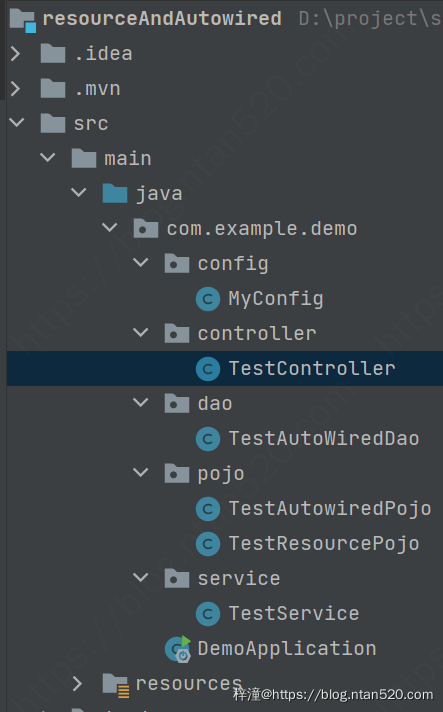文章内容
一、@Autowired和@Resource比较
1、相同点
两个注解都是做bean的注入时使用,可以对成员变量、方法和构造函数进行标注,来完成自动装配的工作。
2、不同点
- 基因不同:@Autowired是由org.springframework.beans.factory.annotation.Autowired提供,换句话说就是由Spring提供;@Resource是由javax.annotation.Resource提供,即J2EE提供,需要JDK1.6及以上。
- @Autowired注解是按照类型(byType)装配依赖对象,默认情况下它要求依赖对象必须存在,如果允许null值,可以设置它的required属性为false。如果我们想使用按照名称(byName)来装配,可以结合@Qualifier注解一起使用。
二、@Resource简介
1、属性
@Resource默认按照ByName自动注入。
@Resource有两个重要的属性:name和type,而Spring将@Resource注解的name属性解析为bean的名字,而type属性则解析为bean的类型。所以,如果使用name属性,则使用byName的自动注入策略,而使用type属性时则使用byType自动注入策略。如果既不制定name也不制定type属性,这时将通过反射机制使用byName自动注入策略。
2、装配顺序
- 如果同时指定了name和type,则从Spring上下文中找到唯一匹配的bean进行装配,找不到则抛出异常
- 如果指定了name,则从上下文中查找名称(id)匹配的bean进行装配,找不到则抛出异常
- 如果指定了type,则从上下文中找到类型匹配的唯一bean进行装配,找不到或者找到多个,都会抛出异常
- 如果既没有指定name,又没有指定type,则自动按照byName方式进行装配;如果没有匹配,则回退为一个原始类型进行匹配,如果匹配则自动装配;
三、Demo示例
1、代码实现
dao层,用于测试注解@Autowired采用ByType方式:
package com.example.demo.dao;
import org.springframework.stereotype.Repository;
@Repository
public class TestAutoWiredDao {
public void autowiredByType(){
System.out.println("Autowired采用ByType匹配");
}
}
package com.example.demo.pojo;
public class TestAutowiredPojo {
public void autowiredByName(){
System.out.println("Autowired采用ByName匹配");
}
}
package com.example.demo.pojo;
public class TestResourcePojo {
public void resourceByName() {
System.out.println("Resource采用ByName匹配");
}
public void resourceByType() {
System.out.println("Resource采用ByType匹配");
}
}
Config配置:
package com.example.demo.config;
import com.example.demo.pojo.TestAutowiredPojo;
import com.example.demo.pojo.TestResourcePojo;
import org.springframework.context.annotation.Bean;
import org.springframework.context.annotation.Configuration;
@Configuration
public class MyConfig {
@Bean
public TestResourcePojo testResourcePojo(){
return new TestResourcePojo();
}
@Bean
public TestAutowiredPojo testAutowiredPojo(){
return new TestAutowiredPojo();
}
}
调用:
package com.example.demo.service;
import com.example.demo.dao.TestAutoWiredDao;
import com.example.demo.pojo.TestAutowiredPojo;
import com.example.demo.pojo.TestResourcePojo;
import org.springframework.beans.factory.annotation.Autowired;
import org.springframework.beans.factory.annotation.Qualifier;
import org.springframework.stereotype.Service;
import javax.annotation.Resource;
@Service
public class TestService {
@Autowired
private TestAutoWiredDao testAutoWiredDao;
@Autowired
@Qualifier("testAutowiredPojo")
private TestAutowiredPojo testAutowiredPojo;
@Resource(name = "testResourcePojo")
private TestResourcePojo testResourcePojoOne;
@Resource(type = TestResourcePojo.class)
private TestResourcePojo testResourcePojoTwo;
public void testAnnotate(){
testAutoWiredDao.autowiredByType();
testAutowiredPojo.autowiredByName();
testResourcePojoOne.resourceByName();
testResourcePojoTwo.resourceByType();
}
}
package com.example.demo.controller;
import com.example.demo.service.TestService;
import org.springframework.beans.factory.annotation.Autowired;
import org.springframework.web.bind.annotation.RequestMapping;
import org.springframework.web.bind.annotation.RestController;
@RestController
public class TestController {
@Autowired
public TestService testService;
@RequestMapping("testAnnotate")
public void testAnnotate(){
testService.testAnnotate();
}
}
2、代码结构

3、运行结果
Autowired采用ByType匹配
Autowired采用ByName匹配
Resource采用ByName匹配
Resource采用ByType匹配
